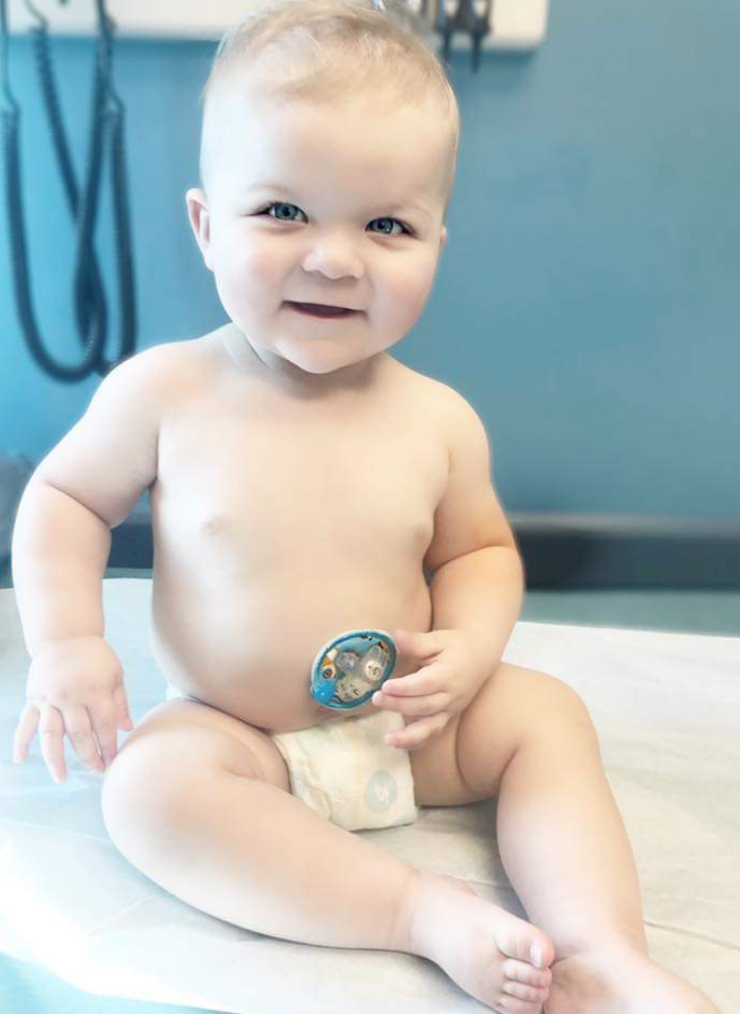
PEG tube feeding
PEG stands for percutaneous endoscopic gastrostomy:
Percutaneous: simply means through the skin
Endoscopic: using a thin camera put though a hole in the skin to visualise an internal organ, in this case the stomach.
Gastrostomy: an artificial opening from the stomach to the skin surface.
Unlike an NG tube, a PEG tube is a permanent, or at least semi permanent feeding tube. It relies on an operation to create an opening directly into the stomach in which a feeding tube can be fixed in place. The benefit of having a PEG tube, is that once the initial operation is done, the tube doesn’t require removing and replacing on a daily basis. The tube is also more subtle than an NG, as it can be concealed under clothing. There are many different reasons why a PEG feeding method might be discussed with you for your baby, so many in fact we can’t list them! But this will be a joint decision between yourself and your baby’s practitioner. It is not an emergency procedure and as such you can spend some time learning about the procedure and why it has been recommended.
Like an NG tube, PEG feeding tubes can be used for breastmilk and formula milk. When older they can be used for liquid food stuffs and of course medications and water.
What is involved in getting a PEG?
It is likely that you will be well versed in tube feeding before a PEG is suggested. These are usually done after NG tube feeding has been commenced, as a longer term alternative. Therefore it is likely it will have been discussed with you on more than one occasion about the possibility of a PEG.
Unlike the NG tube, PEG requires an operation under a general anesthetic, this is where your baby will be ‘put to sleep’ for the duration of the operation. This means an anesthetist is involved and so prior to the surgery, you will be invited to a pre-op assessment, in some hospitals you will be admitted the day before the procedure in order to have everything ready to go.
After the operation, it is likely your baby will need to remain in hospital for a couple of days. This allows you time to learn how to care for the PEG and for the medical team to ensure there were no complications following the insertion (like infection of the wound). You will stay with your baby for their duration of the stay.
For some babies, after six weeks the PEG can be changed to a low-profile balloon gastrostomy device (‘button’). This requires further surgery, where under a general anesthetic the PEG is removed and a low-profile balloon gastrostomy device inserted. If you chose not to have the button and stick with the PEG this needs to be changed every two years.
What are the risks?
This will be discussed with you in detail by your medical team. There are some immediate risks of the surgical insertion. As with all surgeries there are risks of the anesthetic and of the procedure itself. In simplistic terms these include allergic reaction to the anesthetic, bleeding, infection, perforation (where a hole is inadvertently made into the stomach or intestine) and pain. There are risks also associated with PEG feeding, these include pain, infection, aspiration (when stomach contents goes back up the gullet and into the lungs), and leakage. It is likely that if a PEG tube is being sugested than the risks of NOT getting a PEG tube are far greater than getting a tube. If you have any worries or concerns then this should be addressed directly to your medical team.
If your baby has any severe pain, bleeding or leaking from the site then this needs immediately looked at.
Looking after the PEG
In the first few days you need to clean the skin around the site of the PEG with sterile gauze or cloth. This should be done very carefully, so as not to pull at the stitches holding it in place. After the PEG has properly healed then it can be cleaned in a bath or shower and patted dry. Avoid rubbing the site or using any creams or special cleaning fluids as this may irritate the skin and prevent healing. Monitor for signs of infection. This will be redness (or sometimes discolouration of the skin), pain, heat and pus. A small amount of mucus can be normal – like a morning crusty eye! But if you clean it, and the mucus returns or if it is strong smelling then it is worth getting it reviewed by a medical practitioner.
How does feeding work with an PEG tube?
Feeding patterns and volumes will initially be set by the medical team. These can change a lot depending on your baby’s needs. There are three different methods of feeding your baby using the PEG tube
Bolus (intermittent)
Continuous (using a pump)
A combination of both, for example, bolus feeds during the day and a continuous feed overnight.
Some babies may require the PEG feeds as a ‘top up’ in addition to eating (when weaned) and drinking normally, whilst others will remain nil by mouth. And this too may change.
How to administer a feed?
This should be something that is taught to you by your medical team. There are NHS guidelines that you can refer to, but each health board will have their own.
Where do I get the equipment I will need?
Your baby will be discharged from hospital with a supply of tubes and syringes. You will then be able to request any additional supplies you need, this is sometimes done via the GP or sometimes directly to the specialist supplier. Either way, in the UK, these are available on the NHS and should not cost you.
PINNT (Patients on Intravenous and Nasogastric Nutrition Therapy) is an organisation for anyone receiving tube or intravenous feeds. They have a special section for children and young people called Half PINNT.
